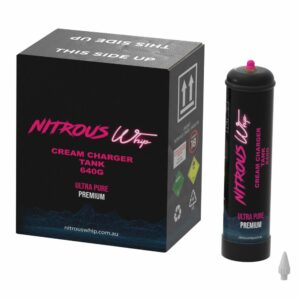The Benefits and drawbacks of Various Materials Utilized in Whip Cream Dispensers and Chargers
Introduction
In today's culinary landscape, whipped cream is more than simply a topping; it's an important element that raises desserts, drinks, and even tasty meals. Whether you're whipping up a wonderful café-style drink or an abundant dessert, the right tools can make all the difference. Go into whipped cream dispensers and battery chargers-- tools developed for accomplishing that perfect fluffy texture. However have you ever questioned the products utilized in these devices? This post dives deep into The Pros and Cons of Various Products Used in Whip Cream Dispensers and Chargers We'll check out whatever from stainless steel to plastic, using insights into how these products effect efficiency, resilience, security, and even environmental implications.
Understanding Cream Chargers
What Are Cream Chargers?
Cream battery chargers are small metal canisters filled with laughing gas (N ₂ O), frequently referred to as "Nangs" or "Nossies." They serve as the propellant for whipped cream dispensers, permitting fast and simple whipping of cream or other liquids.

How Do Whipped Cream Chargers Work?
When you insert a cream charger into a whipped cream dispenser and press the lever, laughing gas is released into the liquid. This gas infuses air into the cream, developing that particular fluffiness all of us nang tanks for sale like.
The Significance of Material Selection
Why Product Matters in Whipped Cream Dispensers
Different products offer varying levels of sturdiness, heat resistance, ease of cleaning, and aesthetics. Picking the right material can impact your user experience significantly.
Overview of Common Materials Used
Let's take a look at each product in detail.

Stainless Steel Dispensers
Benefits of Stainless Steel
- Durability: Stainless steel is understood for its strength and resistance to rust.
- Heat Resistance: It stands up to heats without warping.
- Aesthetic Appeal: The glossy finish offers an expert look.
Drawbacks of Stainless Steel
Despite its many benefits, stainless-steel does have some disadvantages:
- Weight: It can be much heavier than other materials.
- Cost: Greater initial financial investment compared to plastic options.
Summary Table: Stainless-steel Pros & & Cons
|Pros|Cons|| -------------------------|------------------------|| Highly resilient|Can be heavy|| Resistant to rust|More pricey|| Appealing appearance||
Aluminum Dispensers
Advantages of Aluminum
Aluminum dispensers provide an appealing alternative:
- Lightweight: Simpler to handle than stainless steel.
- Cost-effective: Normally more affordable than stainless steel models.
Disadvantages of Aluminum
However, aluminum has its own set of cons:
- Less Long lasting: Prone to damages and scratches.
- Corrosion Risk: Not as resistant to rust as stainless steel.
Summary Table: Aluminum Pros & & Cons
|Pros|Cons|| -------------------------|------------------------|| Lightweight|Less long lasting|| Cost-efficient|Prone to corrosion|

Plastic Dispensers
Overview of Plastic Material
Plastic dispensers are typically marketed as entry-level choices for casual users.
Benefits of Plastic
- Affordability: Incredibly affordable.
- Variety: Offered in various colors and designs.
Drawbacks of Plastic
Nevertheless, there are compromises:
- Durability Issues: More likely to break or crack.
- Heat Level of sensitivity: Can warp under high temperatures.
Summary Table: Plastic Pros & & Cons
|Pros|Cons|| -------------------------|------------------------|| Economical|Less resilient|| Variety readily available|Can warp under heat|
Glass Dispensers
Advantages of Glass Material
Glass is less typical but uses special benefits:
- Non-reactive surface area: Doesn't change flavors.
- Aesthetic Quality: Offers a timeless look.
Disadvantages of Glass
On the flip side:
- Fragility: Much easier to break compared to metal or plastic.
- Weight Concerns: Much heavier than plastic options.
Summary Table: Glass Pros & & Cons
|Pros|Cons|| -------------------------|------------------------|| Non-reactive|Fragile|| Aesthetic appeal|Heavy|
The Toughness Consider Whip Cream Dispenser Materials
Why Resilience Matters?
A long lasting dispenser ensures long-lasting usage without jeopardizing performance over time.
Comparisons In between Materials
When comparing sturdiness:
Safety Factors to consider with Different Materials
Health Effect Concerns
Certain materials may respond with food substances or release hazardous chemicals when heated up or damaged:
Environmental Implications on Product Choices
Sustainability Factors
When picking materials for whip cream dispensers:
Price Contrast Throughout Various Materials
Initial vs Long-Term Costs
While plastic options are cheap upfront:
Use this rate contrast table for recommendation:
Price Contrast Table
|Material|Average Price Variety|| -----------------|-----------------------|| Stainless Steel|$30 - $100|| Aluminum|$20 - $60|| Plastic|$10 - $30|| Glass|$25 - $75|
Maintenance Requirements by Material Type
Cleaning Procedures
Different products need varying care routines:
User Experience: A Matter of Preference
Personalization Opportunities
While some chefs prefer the aesthetics or weight distribution used by stainless-steel: Others enjoy the lightness discovered in aluminum or plastic designs-- ultimately making it a subjective choice based on individual needs!
Conclusion: Making Your Choice
In summary, selecting between various products used in whip cream dispensers boils down to priorities such as durability versus weight or cost-effectiveness versus visual appeal! As we have actually dissected this subject adequately throughout earlier sections concerning pros/cons throughout different types-- it's essential that customers assess their specific requirements before deciding on which type aligns best with them!
FAQs about Whip Cream Dispensers and Chargers
Q1: What are N2O cream chargers used for?
A1: N2O cream chargers are mainly utilized as propellants in whipped cream dispensers for producing fluffy textures rapidly and efficiently.
Q2: Are nitrous oxide cream chargers safe?
A2: Yes, when used according to manufacturers' standards they're generally considered safe; nevertheless misuse can result in health risks associated with inhalation or improper handling!
Q3: How do I clean my whip cream dispenser?
A3: Typically speaking-- it's advised hand washing all parts other than those marked dishwasher-safe utilizing warm soapy water followed by comprehensive rinsing!
Q4: Where can I purchase whip cream chargers?
A4: You can buy whipped cream chargers from local kitchen supply stores online retailers concentrating on culinary tools-- or perhaps from some supermarkets!
Q5: Exists any difference between numerous brands?
A5: While most brand names work similarly-- there may be variations worrying quality control consistency which could affect performance reliability long term!
Q6: Can I refill my nitrous oxide cartridges?
A6: No-- it's not recommended nor safe; as soon as empty cartridges should be disposed properly according regional policies relating to contaminated materials disposal methods!
